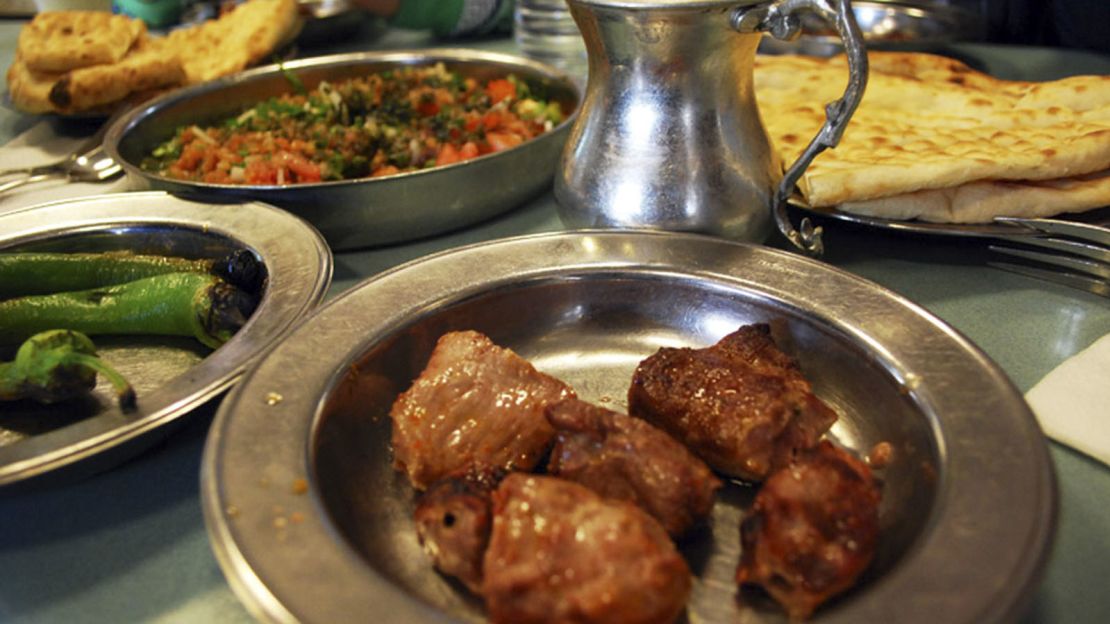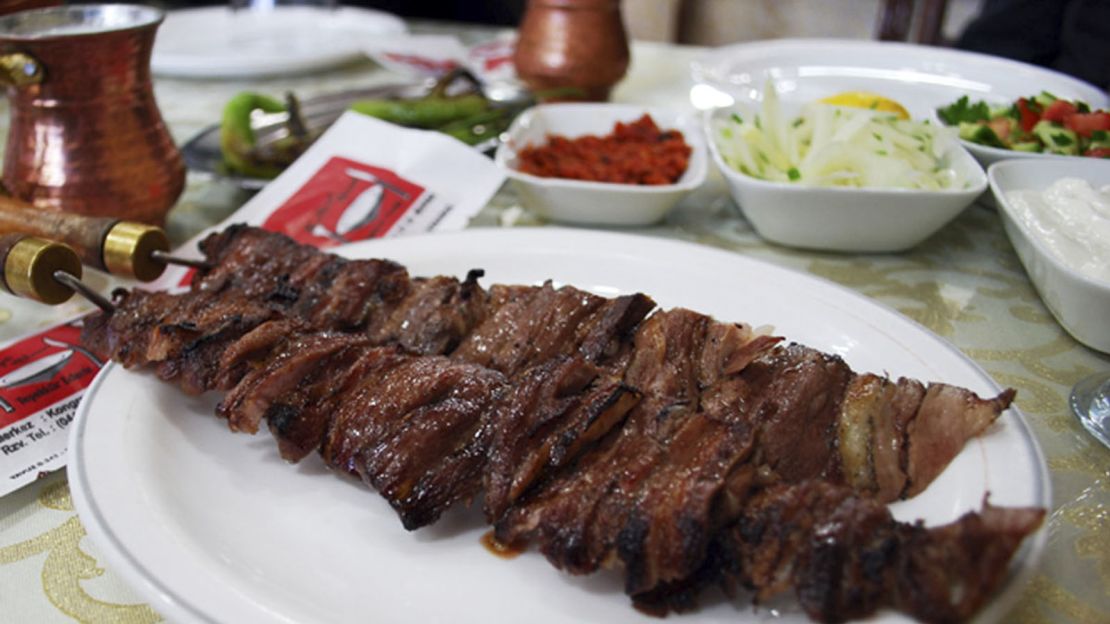Editor’s Note: This story complements the Culinary Journeys TV series, airing monthly on CNN International. This month we follow Noma’s Rene Redzepi to Istanbul. Learn more about the show here: www.cnn.com/journeys.
Put any kind of meat on a stick and roast it over a flame and it immediately becomes food fit for gods.
No country understands this sacred rule of seared meat like Turkey.
Turkish kebabs are the incarnation of the meat lover’s most exotic fantasies, with grilled lamb, beef and chicken as skewer MVPs.
Most kebab restaurants also have a long list of Turkish starters called meze that are as delicious as the main dishes.
Turkey’s best alcoholic complement for all that meat is raki – an aniseed-flavored drink that’s often diluted with water and chilled with ice.
Frothy, yogurt-based ayran is a great non-alcoholic complement to heavy dishes.
But who are we kidding – you just want the meat.
Here’s where to get it in Turkey.
Hamdi Restaurant (Istanbul)
Located just steps from the Egyptian Bazaar in Eminonu, Hamdi Restaurant isn’t just a stop on the way to the bazaar but a destination itself.
Specializing in southeastern cuisines, it affords a magnificent view of the Golden Horn, the Galata Tower and Eminonu.
Since window-side tables are in high demand, making a reservation in advance is highly recommended.
A signature dish is the testi kebabi. Cooked over charcoal in a clay jug covered with dough for three to four hours, the dish is made with veal, tomatoes, onions, garlic, pepper, oregano, tomato paste and butter.
It’s quite a ceremony to watch this extraordinary dish being served – waiters break the jug in front of you to reveal the meal inside.
Another must is the hashas kebabi made with minced veal and lamb, and mixed with capsicum, salt and pepper.
Halil Usta and Imam Cagdas (Gaziantep)

Two kebab restaurants reign supreme in the southeastern city of Gaziantep: Kebapci Halil Usta and Imam Cagdas.
Open since 1972, Halil Usta is a humble establishment with a dedicated following.
Its tender meat has made such a name over the years that this lunch-only restaurant runs out of meat by 3 p.m. almost every day.
Most notable is kusleme, a velvety soft lamb kebab served in copper pots.
Although a side dish, the salad (greens, tomatoes, mint, thyme, red pepper, pomegranate molasses and spices) can stand proudly on its own.
Unlike Halil Usta, Imam Cagdas is large and modern.
Standout dishes include ali nazik – lamb served on top of a bed of char-grilled yogurt-eggplant puree – and alti ezmeli tike kebabi, a stew-like kebab made with lamb served on top of a tomato and pepper mash.
The restaurant’s flaky, pistachio-filled baklava is as celebrated as its kebabs.
Onbasilar (Adana)
Adana kebap is one of the most famous styles of kebabs – visitors should try to savor it in its hometown.
Onbasilar is a fine place to give it a try.
Grilled over charcoal, this spicy, minced-lamb kebab is served with charred tomatoes, peppers and onions with sumac and lavas (thin flatbread).
It’s best paired with a regional drink called salgam, made with fermented pickled carrot juice, while the kadayif, a pistachio-filled shredded pastry in syrup, is the best choice for dessert.
Recommended: a table with a view of the Seyhan Lake.
Koc Cag Kebabi (Erzurum)

The eastern city of Erzurum is home to Koc Cag Kebabi, a modest eatery where the unique cag kebabi originated.
Cag kebabi is made of lamb marinated with onions, salt and pepper for 12 hours then placed on a large, horizontal skewer and cooked over a wood fire.
The traditional way to eat this succulent meat is with your hands or wrapped in lavas.
Travelers who can’t make it to Erzurum can try sehzade cag kebabi in Sirkeci.
Ciya Kebap (Istanbul)
What started out as a simple kebab shop in 1987 in Kadikoy has become one of the city’s most revered culinary treasures.
Ciya’s founder Musa Dagdeviren, who hails from Gaziantep and has generations of bakers’ DNA running through him, went from preparing the best lahmacun to running three restaurants on the same block, two focusing on kebabs and one offering regional specialties mainly from the east.
Offering ever-changing seasonal dishes, Ciya’s menu includes unique kebab varieties (some invented and others true to their original forms).
Ali Haydar (Istanbul)
Located in a nostalgic square of the city in the once multi-ethnic neighborhood of Samatya, Ali Haydar is a true meyhane (Turkish tavern).
Offering delectable mezes like patlican salatasi (eggplant salad), saksuka (fried eggplant with tomatoes) and haydari (a yogurt-based dish with garlic), this down-to-earth venue steals the show with its juicy and tender kebabs.
You’ll find the classic varieties here, from ali nazik to sarma beyti, but getting the mixed platter with urfa kebabi, fistikli kebap (with pistachios) and tavuk sis (chicken on skewers) makes things easier.
Raki is the drink of the hour while local musicians playing classical Turkish tavern music as they walk by is the performance of the night.
Cercis Murat Konagi (Mardin)
Located in a traditional 19th-century konak (stone mansion), Cercis Murat Konagi offers authentic Mardin cuisine.
This mystical land has been home to a variety of different cultures over the centuries and this multicultural essence is evident in many aspects of Mardin, including its food.
Restaurant owner Ebru Baybara Demir’s extensive research into the area’s cuisine is reflected in the menu. Many native Turkish speakers would be unfamiliar with most of the meals and their names – such as alluciye, incasiye and himmisiye – which are all regional specialties worth trying.
The local kebab varieties, like kazan kebabi made with eggplant, minced beef, tomatoes, onions and other delicious ingredients, coupled with majestic views, make Cercis Murat Konagi a must-stop on the kebab trail.
Cercis Murat Konagi, Birinci Cadde No: 517, Mardin; +90 482 213 68 41








